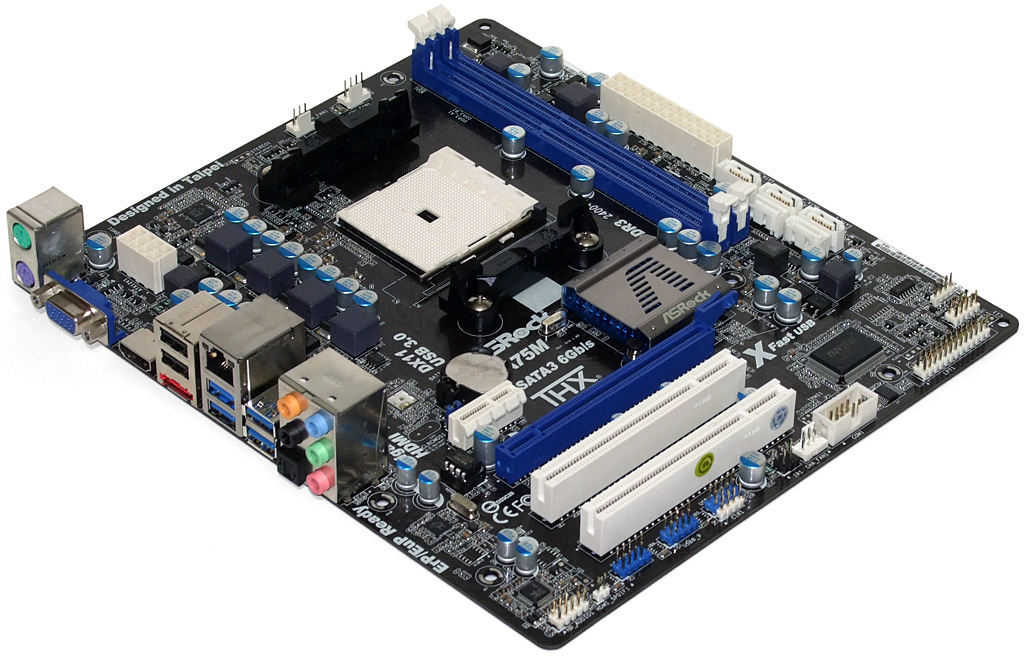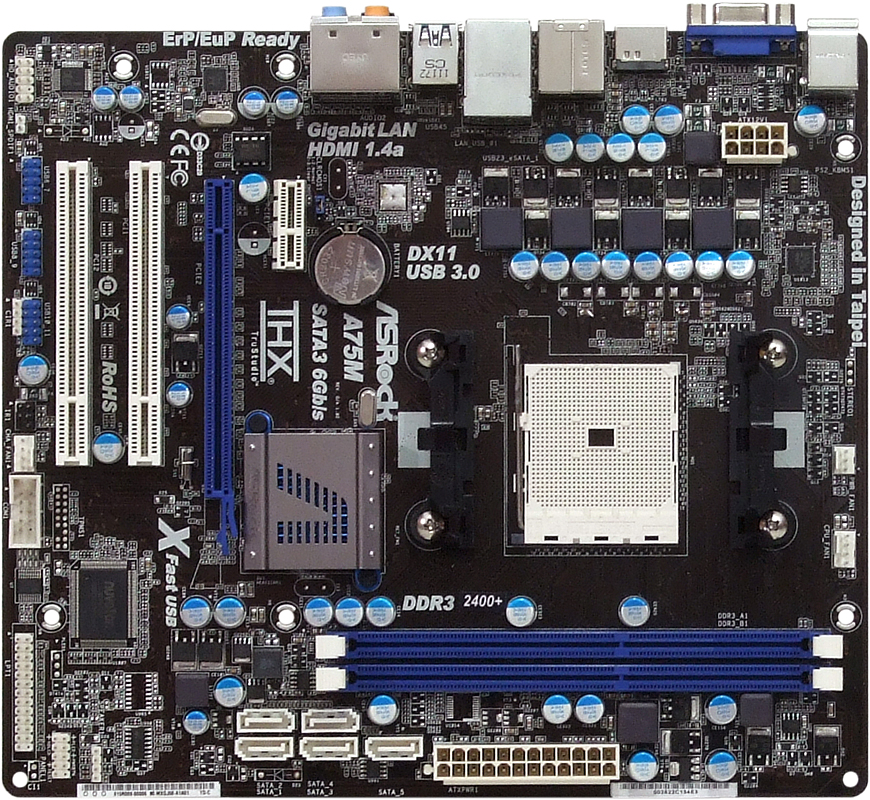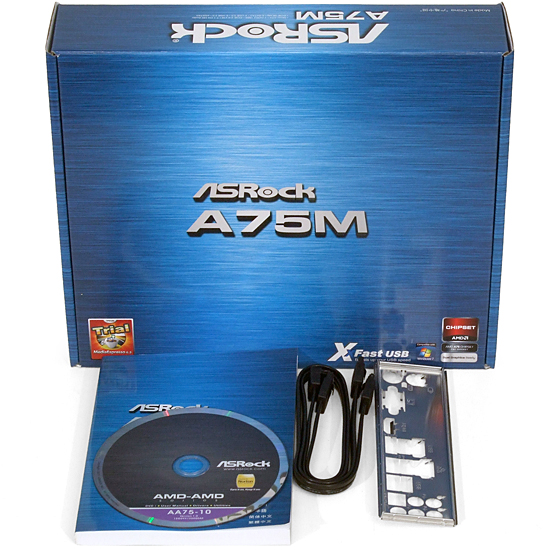Six A75-Based Motherboards For AMD’s A8 And A6 APUs
Advanced on-board graphics put AMD’s Llano-based APU far ahead of Intel’s Sandy Bridge architecture, at least when it comes to 3D apps. But you’ll still need a new motherboard to support the Socket FM1 platform. Today we test six affordable contenders.
ASRock A75M
We like short, easy-to-remember names, and the A75M certainly delivers on that wish. But does a short name also imply a short list of features?
The board's rear panel lacks a DVI output, but that could be excused if we view this as an HTPC-oriented part. Llano’s two different built-in GPUs are powerful enough to satisfy that role. They're even capable of light gaming duties. HDMI is, of course, backward-compatible with DVI. But if you want to attach a DVI display to this platform, you'll need to purchase either an adapter block or adapter cable.
ASRock questionably places all four of the A75 FCH’s USB 3.0 ports on the A75M's rear panel, leaving only USB 2.0 headers for front-panel ports. This might appear an odd move from the first company to respond to our call for standardized front-panel USB 3.0 connectors, but this could be in deference to traditional HTPC-oriented cases, which evolve more slowly than gaming enclosures and still typically lack USB 3.0 jacks.
If this were intended to sit in as an HTPC-specific design, we'd say that the board's PCIe x16 slot placement isn't quite right, since graphics riser cards typically align with the top slot. But if we use the A75M as a vehicle for utilizing integrated graphics, the top x1 slot could be used with a riser to support a tuner card.
Five SATA 6Gb/s ports connect internal drives, while a sixth port goes to the I/O panel for eSATA. All five ports are placed above the x16 slot to eliminate card clearance issues, though placing them there on such a narrow layout eliminates the flexibility to expose four DIMM slots (as you can see in the picture above). If you find yourself unable to live without memory expansion, ASRock does sell full-width models with the extra slots.
Less HTPC-oriented features include the full-sized serial and parallel port headers, which are most frequently needed to retain compatibility with old peripherals in commercial environments. That secondary market could also explain the presence of a legacy VGA connector on the back panel, where we'd rather see DVI or DisplayPort.
Two SATA cables accompany the A75M. Though we prefer to see at least four cables with microATX or larger motherboards, this is enough to comply with the basic needs of most builders. An online price of only $80 makes it even harder to fault the sparse installation kit.
Get Tom's Hardware's best news and in-depth reviews, straight to your inbox.
Current page: ASRock A75M
Prev Page AMD's A75 Platform: The Triumph Of Adequacy Next Page Overclocking ASRock's A75M-
dogman_1234 Thank You for the Review. I am glad to see you guys taking this and pushing it to the limits. Can't wait until SB-E and Bulldozer reviews.Reply
Qne question, what does the APU,( either the A6 or the A8), have on F@H applications? -
Crashman dogman_1234Thank You for the Review. I am glad to see you guys taking this and pushing it to the limits. Can't wait until SB-E and Bulldozer reviews.Qne question, what does the APU,( either the A6 or the A8), have on F@H applications?Since I haven't joined F@H, I can only recommend going to a F@H forum to find someone who's tried it.Reply
I know F@H is a great cause, might cure cancer etc, but wouldn't it be more geeky to search for radio signals of little green men? -
_Pez_ what about blue-ray playback? and power consumption when playing it. I'm planing a HTPC. And those small form factor are really appealing. especially Gigabyte’s A75M-UD2H, I will get that one.Reply -
Crashman _Pez_what about blue-ray playback? and power consumption when playing it. I'm planing a HTPC. And those small form factor are really appealing. especially Gigabyte’s A75M-UD2H, I will get that one.SFF properly translates to DTX and Mini ITX. These are Micro ATX...Reply
I checked the CPU reviews and didn't see anything there either. You know it's going to be low utilization for these processors, which means it will be closer to the idle power than to the full-load power... -
buzznut I remember when the Gigabyte board first was launched, I though it looked pretty sweet then even posted a poll on it. I'd have to agree, it seems like the board to have for A8. Looks good too, although I a find Gigabyte's non-blue/white scheme offerings more attractive. Just ordered my 990FX UD5, can't wait!Reply -
buzznut CrashmanSFF properly translates to DTX and Mini ITX. These are Micro ATX...I checked the CPU reviews and didn't see anything there either. You know it's going to be low utilization for these processors, which means it will be closer to the idle power than to the full-load power...Reply
I think micro atx fits into plenty of SFF cases. Maybe we need to redefine..
I'd like to see a showdown of mini itx boards though, I think Anand did something like that recently. That's probably where the A8 CPU's need to go head to head with atom anyway, most reviews I've seen show the CPU's aren't all that cut out for desktop. Maybe the next batch that comes out in Q4/Q1 2012 will be better for desktop. -
tacoslave buzznutI think micro atx fits into plenty of SFF cases. Maybe we need to redefine..I'd like to see a showdown of mini itx boards though, I think Anand did something like that recently. That's probably where the A8 CPU's need to go head to head with atom anyway, most reviews I've seen show the CPU's aren't all that cut out for desktop. Maybe the next batch that comes out in Q4/Q1 2012 will be better for desktop.lol wut? Dude you got this QUAD CORE based on the phenom II architecture mixed up with the e-350 or the c-50 those are the ones that are going up against Atom.Reply
-
Crashman buzznutI think micro atx fits into plenty of SFF cases. Maybe we need to redefine.That would make you part of the problem rather than part of the solution.Reply
1.) SFF originally stood for Shuttle Form Factor and was proprietary, using 2-slots.
2.) It was copied by companies like First International Computer and AOpen
3.) AMD established a standard for "open architecture" systems of similar design, called DTX.
4.) ITX is smaller than DTX and fits DTX cases.
Notice this has nothing to do with Micro ATX. People who claim that anything shaped like a cube is SFF need only be shown a full ATX cube before they start making excuses. People who point to horizontal cases and say SFF need only look at ancient AT desktops before they're forced to come up with excuses.
2-slots. That's what makes Shuttle copies different from everything else. Cubes can be any "size", HTPC's can be any "size", if SFF is a size standard it can only be used to apply to two-slot cases.
Some competitors have been trying for years to expand the definition of SFF. They are, of course, wrong.
Nobody's perfect, one of Tom's old team members once said that barebones always refers to SFF systems (even though full sized barebones existed long before SFF). But at least Tom's tries to fix those types of errors rather than force them into the vernacular.
I'm just asking people to be specific. If you mean cube, say cube. If you mean desktop, say desktop. If you mean mini-tower, slim tower, or slim desktop, just say it. Then apply a form factor "Mini ITX slim tower" or "Micro ATX desktop". And if you're saying "SFF" rather than media center, well it's obvious that SFF can do other things so just be specific and say media center.
If you're not specific, you might find yourself in a discussion about what the meaning of "is" is.
-
noob2222 I have the gigabyte board and undervolted by .2 running stock speeds. Its used for my HTPC setup so for me making it silent and less power draw were the key points. I have an oversized fanless heatsink and never have issues. When I do run a game on it for fun, the case fan will kick up, but watching movies it stays silent.Reply
Would love to see some benches on the gigabyte with those max overclock numbers as the GPU would benefit greatly from the memory oc. -
Crashman noob2222I have the gigabyte board and undervolted by .2 running stock speeds. Its used for my HTPC setup so for me making it silent and less power draw were the key points. I have an oversized fanless heatsink and never have issues. When I do run a game on it for fun, the case fan will kick up, but watching movies it stays silent.Would love to see some benches on the gigabyte with those max overclock numbers as the GPU would benefit greatly from the memory oc.Good News! Tom's Hardware is working on a memory article using one of these boards, and has included games in the test!Reply



